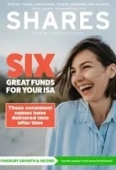How to beat the incoming capital gains tax hike

More than a quarter of a million more people and trusts will be paying capital gains tax for the first time, according to HMRC figures, thanks to the Government crackdown on gains. From April the tax-free allowance for CGT (capital gains tax) will be less than a quarter of what it was just a year ago, dragging more people into paying tax and filing a tax return.
The CGT allowance was cut from £12,300 to £6,000 for the current tax year and will be chopped in half again from April, to just £3,000. It means that from 6 April 2024 a higher-rate taxpayer will pay up to £1,860 more tax on their investments compared to a year ago, assuming they realise gains up to the previous £12,300 limit, while a basic-rate taxpayer will be hit with up to £930 more on their tax bill.
But there’s still time before the tax year end to protect your investments from the taxman. Some clever financial planning now can help you keep more of your money not just next year, but in future years.
USE UP YOUR ALLOWANCES
If you’re sitting on large capital gains outside an ISA or pension you can use up your tax-free allowance of £6,000 this year before it’s slashed to £3,000. If you sell investments to realise gains up to this level you won’t pay any tax on the money. You just need to check what gains you’ve already realised this tax year, across all your investments, and make sure you don’t exceed the tax-free limit.
FILL YOUR ISA
If you have investments outside a tax wrapper the savviest move is to transfer that money into an ISA, or into a pension if you can afford to tuck it away for longer. You’ll need to check how much ISA allowance you have remaining this tax year to make sure you don’t go over the £20,000 annual limit.
For those sitting on large capital gains you can sell assets to realise a gain up to your remaining tax-free allowance and then buy it back within your ISA, which means you’ll make use of the tax-free allowance and protect any future gains from the taxman. You can use your platform’s Bed and ISA service, just make sure you check the deadline, which is usually a few working days before the tax year end.
TRANSFER MONEY TO YOUR SPOUSE
Any investments transferred to your spouse or civil partner are exempt from capital gains tax. This means that if your spouse hasn’t used up their tax-free allowance this year and has some ISA allowance remaining you can make use of those tax breaks. You just need to make sure you keep a note of the original cost of the asset, as that’s what will be used when your partner comes to sell it.
If your spouse is in a lower income tax bracket to you there’s a double benefit, as they will pay capital gains tax at a lower rate. That means even if they have used up their tax-free CGT allowance, there could still be a benefit to transferring the assets to them. For example, if you have a £5,000 gain and have already used your allowance a basic-rate taxpayer would pay £500 in CGT while a higher-rate payer would pay £1,000 – meaning a potential saving of £500.
USE YOUR LOSSES
While no investor wants to make a loss, losses can be your friend for capital gains tax purposes. Losses made in the current tax year can be offset against any gains before you deduct the tax-free allowance. If you don’t use them this year you can carry forward any losses for future tax years, to offset against any future gains. Just make sure you register the losses with HMRC within four years after the end of the tax year in which you made the sale in question.
USE PENSION CONTRIBUTIONS TO DROP YOUR TAX BAND
One particularly clever trick is to use your pension contributions to reduce your income tax band. When you contribute to your SIPP, the gross value of the contribution has the effect of extending your basic rate tax band. This means that the rate of capital gains tax you pay could be lower if it means you are no longer a higher-rate taxpayer. This is a particularly handy trick if you’ve only just tipped over into the next tax band, meaning a small pension contribution would bring you under the threshold. If you have used your full pension allowance this year or cannot make a pension contribution, you can also lower your taxable income by donating to charity. If you’re eligible, you can then also claim gift aid on the donation.
Important information:
These articles are provided by Shares magazine which is published by AJ Bell Media, a part of AJ Bell. Shares is not written by AJ Bell.
Shares is provided for your general information and use and is not a personal recommendation to invest. It is not intended to be relied upon by you in making or not making any investment decisions. The investments referred to in these articles will not be suitable for all investors. If in doubt please seek appropriate independent financial advice.
Investors acting on the information in these articles do so at their own risk and AJ Bell Media and its staff do not accept liability for losses suffered by investors as a result of their investment decisions.
Issue contents
Editor's View
Feature
Great Ideas
Money Matters
News
- Why interest in Currys could spark further mergers and acquisitions in the sector
- What have the top US fund managers been doing recently?
- XP Power plummets to 10-year low after two successive profit warnings
- YouGov looks in great shape amid talk of move to US listing
- Uber unveils $7 billion buyback as ride hailing firm shocks investors

 magazine
magazine








